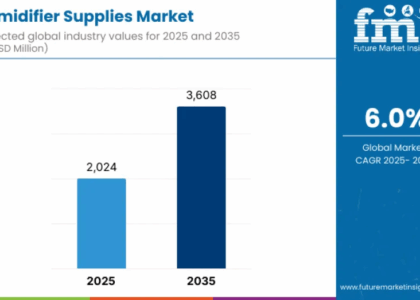
The global vibration control systems market is projected to grow steadily, with sales estimated at USD 5.9 billion in 2025, reflecting a year-over-year growth of 5.8% from USD 5.6 billion in 2024. Looking ahead, the market is poised for significant expansion, expected to reach approximately USD 10.8 billion by 2035. This growth trajectory represents a compound annual growth rate (CAGR) of 6.2% over the forecast period from 2025 to 2035, driven by rising demand for vibration mitigation in advanced manufacturing, infrastructure, aerospace, and automotive sectors.
As industries such as automotive, aerospace, manufacturing, electronics, and civil infrastructure continue to advance technologically, the demand for sophisticated vibration mitigation solutions has become more prominent. These systems not only improve the longevity of critical equipment but also enhance safety, operational efficiency, and user comfort. With growing investments in smart manufacturing, infrastructure development, and high-performance machinery, the vibration control systems market is poised for consistent expansion in the coming decade.
Uncover Market Opportunities: Access a Sample Report Now!https://www.futuremarketinsights.com/reports/sample/rep-gb-4595
Driving Forces Behind Market Growth
- Growing Focus on Equipment Longevity and Reliability
One of the primary drivers of the vibration control systems market is the rising demand for reliable and long-lasting machinery. Excessive vibration can lead to premature wear and tear, mechanical failures, and unplanned downtime. Industries are increasingly integrating vibration control components to ensure operational continuity, reduce maintenance costs, and extend asset lifecycles. - Surge in Automotive and Aerospace Manufacturing
Modern automotive and aerospace designs require high-performance vibration dampening systems to ensure comfort, safety, and structural stability. From suspension systems to engine mounts, vibration control technologies are vital in reducing noise, harshness, and vibration (NHV), making them critical in electric vehicles (EVs), autonomous systems, and advanced aircraft. - Rapid Infrastructure Development
Urban expansion and mega infrastructure projects across developing regions are propelling the use of vibration control systems in buildings, bridges, and railways. Structural vibration isolation is essential in earthquake-prone zones and in buildings housing sensitive equipment such as laboratories, hospitals, and data centers. - Rise of Precision Manufacturing and Microelectronics
Industries such as semiconductor fabrication, optics, and medical device manufacturing demand environments free of micro-vibrations that can compromise precision. Vibration isolation platforms and advanced damping systems are increasingly being adopted to maintain tolerances and product quality in these sectors. - Technological Advancements in Smart Vibration Control
Innovations in materials science, sensors, and control algorithms have led to the development of active vibration control systems that adapt in real-time. These systems are gaining traction in high-performance applications like aerospace engineering, military vehicles, and high-end manufacturing.
Market Challenges & Strategic Responses
- High Installation and Maintenance Costs
While the benefits of vibration control systems are significant, their upfront cost and ongoing maintenance can be a barrier, particularly for small and medium-sized enterprises (SMEs). Strategic responses include the development of modular, retrofittable systems and cost-optimized materials that reduce the total cost of ownership. - Complexity in Customization
Different applications often require tailored solutions based on load, frequency range, and environmental conditions. This complexity can limit scalability. To address this, leading manufacturers are focusing on versatile designs and simulation-based engineering to streamline customization while minimizing production costs. - Lack of Awareness in Emerging Markets
In some developing regions, limited awareness about the long-term benefits of vibration control leads to underinvestment. Market players are responding with educational outreach, technical demonstrations, and local partnerships to showcase value propositions to industrial stakeholders. - Competition from Alternative Technologies
Some applications may choose alternative solutions like hydraulic dampers or simplified mechanical isolators that offer lower performance at lower costs. In response, companies are enhancing product differentiation through integrated smart monitoring and IoT-based predictive maintenance capabilities. - Supply Chain Disruptions and Material Costs
Like many industrial sectors, the vibration control systems market faces challenges related to fluctuating raw material prices and global supply chain instability. Strategic responses include diversifying supplier networks, regionalizing production, and investing in recyclable and sustainable materials.
Accelerated Market Demand: Find Comprehensive Insights and Trends in Our Full Report!https://www.futuremarketinsights.com/reports/vibration-control-systems-market
Regional Market Outlook
North America:
North America holds a significant share of the global vibration control systems market, led by advanced aerospace, automotive, and construction industries in the U.S. and Canada. Investment in smart buildings, industrial automation, and seismic retrofitting of infrastructure further boosts demand. Additionally, the region’s leadership in R&D fosters early adoption of next-gen vibration mitigation technologies.
Europe:
Europe is a mature market with strong adoption driven by stringent building codes, environmental standards, and a focus on precision engineering. Countries such as Germany, France, and the UK are at the forefront of deploying vibration control systems in both industrial and civil sectors. The EU’s emphasis on sustainability and workplace safety will continue to support market growth in the region.
Asia-Pacific:
The Asia-Pacific region is the fastest-growing market, fueled by rapid industrialization, urbanization, and infrastructure development across China, India, Japan, and Southeast Asia. Rising investments in transportation, electronics manufacturing, and renewable energy are expanding the application scope for vibration control technologies. Government initiatives promoting smart cities and high-speed rail networks also present lucrative opportunities.
Middle East & Africa:
In the Middle East and Africa, the demand for vibration control systems is driven by large-scale construction projects, oil & gas operations, and water treatment infrastructure. Countries such as Saudi Arabia and the UAE are investing in seismic-resistant structures and advanced industrial facilities, where vibration mitigation is critical to safety and performance.
Latin America:
Latin America is an emerging market with growth opportunities in mining, construction, and energy. Brazil, Mexico, and Chile are seeing increased adoption of vibration control systems in infrastructure and manufacturing sectors. However, market penetration remains limited due to budget constraints and a lack of technical awareness, offering room for targeted expansion.
Key Players
- HUTCHINSON
- DynaTronic Corporation Ltd.
- Cooper Standard
- GERB
- Technical Manufacturing Corporation
- LORD Corporation
- Trelleborg AB
- Farat Ltd
- Bridgestone Corporation
- FUKOKU CO., LTD
Operational Equipment Industry Analysis:https://www.futuremarketinsights.com/industry-analysis/operational-equipment
Key Segmentation
By System Type:
In terms of system type, the industry is divided into vibration controls, motion controls and automation control. vibration controls is further segmented into isolating pads, isolators (metal, rubber), couplings (spool, shear, bolt, bush) and Anti-Vib cylinders (male, female).
Similarly motion controls is further segmented into springs (air, coil), hangers, washers & brushes and mounts (hydraulic, pneumatic). Again automation control is segmented into absorber (miniature, industrial, heavy industrial) and dampers (hydraulic, pneumatic, damping pads)
By End User:
In terms of end user, the industry is divided into mining & quarrying, oil & gas, utilities, automotive, aerospace, food and Beverage, chemical manufacturing, electrical equipment, machinery manufacturing and others.
By Sales Type:
In terms of sales type, the industry is divided into O.E.M and aftermarket.
By Region:
Key regions of North America, Latin America, Western Europe, Eastern Europe, East Asia, South Asia Pacific and Middle East & Africa have been covered in the report.
About Future Market Insights (FMI)
Future Market Insights, Inc. (ESOMAR certified, recipient of the Stevie Award, and a member of the Greater New York Chamber of Commerce) offers profound insights into the driving factors that are boosting demand in the market. FMI stands as the leading global provider of market intelligence, advisory services, consulting, and events for the Packaging, Food and Beverage, Consumer Technology, Healthcare, Industrial, and Chemicals markets. With a vast team of over 400 analysts worldwide, FMI provides global, regional, and local expertise on diverse domains and industry trends across more than 110 countries. Join us as we commemorate 10 years of delivering trusted market insights. Reflecting on a decade of achievements, we continue to lead with integrity, innovation, and expertise.
Contact Us:
Future Market Insights Inc.
Christiana Corporate, 200 Continental Drive,
Suite 401, Newark, Delaware – 19713, USA
T: +1-347-918-3531
For Sales Enquiries: sales@futuremarketinsights.com
Website: https://www.futuremarketinsights.com
LinkedIn| Twitter| Blogs | YouTube





